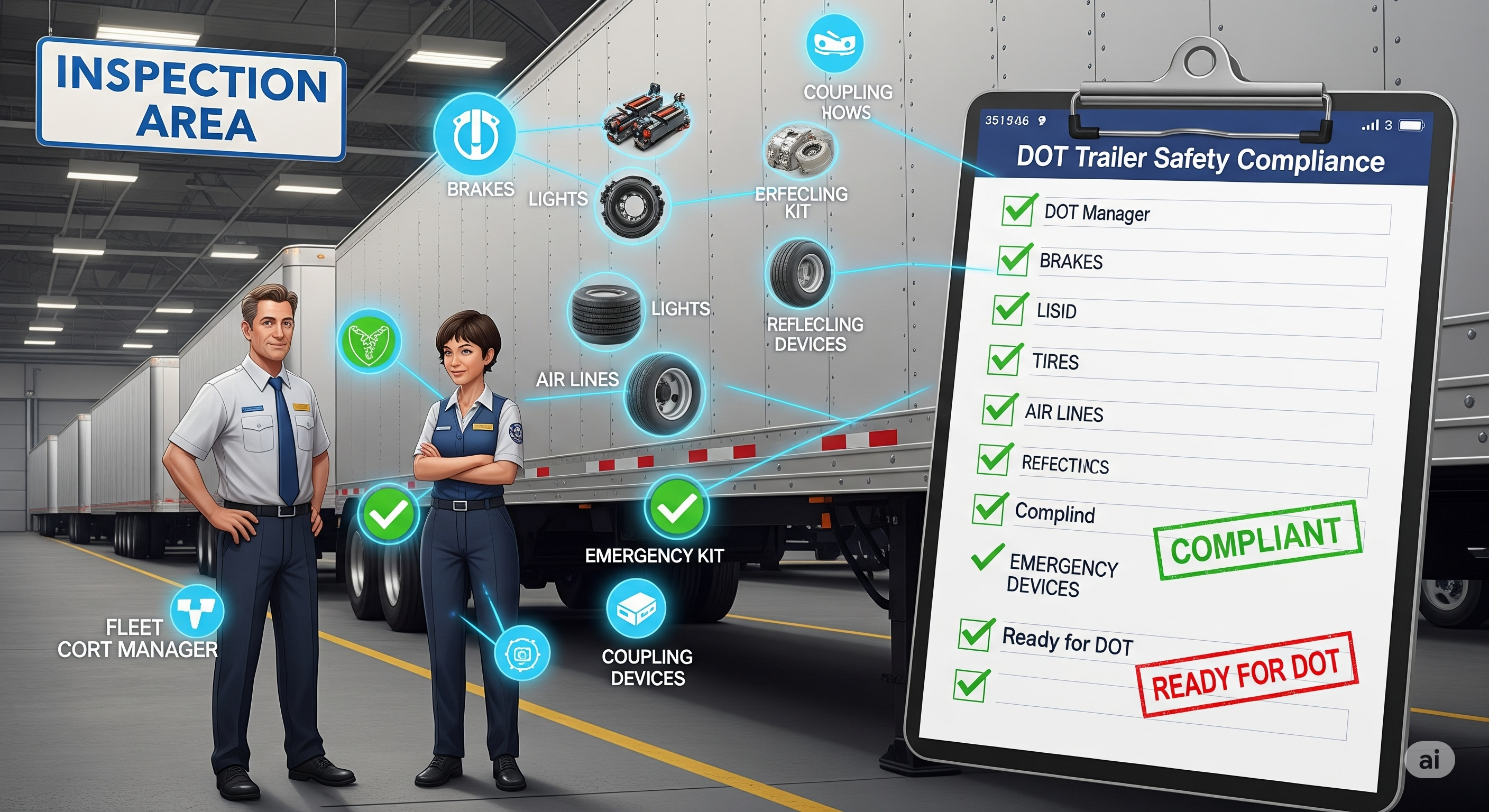DOT Readiness: Trailer Safety Checklist for Compliance Success

Failing a DOT truck inspection doesn’t just lead to fines; it means delays, lost loads, and trucks sitting instead of rolling. And for any fleet owner or manager, that's a no-go. If you’re juggling dispatch calls, keeping customers happy, and trying to keep drivers moving, you know trailer safety isn’t just about playing by the rules; it’s about protecting your business.
DOT officers don’t give you a pass for being busy. They look at the facts: brakes working? Lights on? Tires in good shape? It is why a good trailer safety checklist is the first line of defence when it comes to a failed inspection, violations, and red tape, which can slow down the entire operation with which you are involved. Regardless of how many trailers you operate, 5 or 50, DOT truck inspection readiness should be part of your daily menu.
So here goes an unvarnished list of things that should help keep your trailers in compliance and your CSA score free of blemishes, and keep your loads on the road and out of snags.
1. Check Brake Systems
No surprise here, brakes are a top reason for violations and out-of-service orders. If you’ve got worn shoes, air leaks, or malfunctioning slack adjusters, it’s game over.
- Look for: cracked brake linings, damaged hoses, or non-working spring brakes.
- Listen for: any hissing sound during walk-arounds (air leaks).
- Test: brakes during pre-trip with full pressure and watch for delay or uneven stops.
Pro tip: Schedule weekly brake checks if your trailers run heavy or cover long hauls. It could save you from a failed DOT truck inspection or worse, a rear-end accident.
2. Inspect Suspension and Axles
Your trailer can also ride rough, wear tires, and move loads due to bent axles, broken leaf springs, and/or broken torque arms. And DOT officers will surely raise anything that is off-balance or askew.
- Walk around and inspect the trailers that are leaning or sagging.
- Check U-bolts, spring hangers, and air bags.
- Listen for creaks, knocks, or grinding under load.
A small suspension issue today could lead to downtime tomorrow, and nobody wants that call from dispatch saying, “The trailer’s bouncing like crazy.”
3. Tire Condition and Pressure
A bald tire isn’t just a ticket; it’s a blowout waiting to happen. Tires are one of the most obvious DOT violations and easiest to catch ahead of time.
- Minimum tread: 2/32" for trailers; anything less is a violation.
- Sidewalls: Look for bubbles, cracks, or embedded objects.
- Pressure: Check with a gauge, don’t rely on “eye checks.”
Fleet Hack: Use tire pressure monitoring systems (TPMS) to save time and catch leaks before the trailer’s rolling empty with a flat.
4. Lights, Reflectors, and Wiring
Lighting issues are one of the first things DOT officers catch, because they’re so visible. And let’s face it, a busted taillight is a silly reason to fail an inspection.
- Ensure: Brake lights, turn signals, clearance, and ID lamps all work properly.
- Confirm: If reflectors are clean and visible.
Add this to your pre-trip routine or daily yard checklist. It’s a quick win that helps your team pass a DOT truck inspection without fuss.
5. Secure Doors, Seals, and Floors
DOT will neither load nor certify a trailer that is unable to secure cargo well. This implies roll-up doors, seals, floors, and locking mechanisms should be in excellent condition.
· Check: Both rear and side access doors and look at the tracks in case they have bent or the hinges have broken.
· Examine: Soft spots, rot and rust holes, or holes through the metal of floorboards.
· Ensure: Seals on cargo are well fitted, waterproof, and undisturbed.
And particularly wise in case you are carrying sensitive or covered cargo. A flimsy latch will lose you the load and also your safety rating.
6. Landing Gear and Couplers
Landing gear failure isn’t just an inconvenience; it can destroy a trailer or injure someone during a drop. DOT wants to see sturdy, rust-free, and working gears.
- Grease: Landing gear mechanisms to prevent freeze-ups or grinding.
- Inspect: Legs for damage, rust, or bends.
- Check: Kingpin and coupler wear, and make sure the locking jaws engage fully.
Make it a habit to do a quick gear crank test every time a trailer is dropped. Prevention beats a roadside failure every single time.
7. Emergency Equipment Onboard
DOT also checks for required emergency gear, and yes, they will fine you if it’s missing or expired.
- Fire extinguisher: Fully charged and mounted securely.
- Triangles: Three reflective triangles in good condition.
- Spare fuses: Enough for each type used in your trailer.
Simple checklist items, but when you’re busy running the show, these small details are easy to forget. Train your drivers to double-check before hitting the road.
8. Paperwork and Inspections Up to Date
DOT doesn’t just inspect equipment; they’ll want to see proof that you’ve been staying compliant.
- Keep: Annual inspection stickers current and visible.
- Store: Previous inspection reports and repair records in-cab or in the yard.
- Make sure: Driver logs and DVIRs match reality. Inconsistencies can trigger deeper inspections.
Pro Tip: Set up a digital system or mobile app to track inspection schedules and reminders. Doesn’t have to be fancy, just reliable.
Final Thoughts: Stay Ready So You Don’t Get Shut Down
To the owners, operators, and fleet managers, it is not a matter of luck that one passes a DOT truck inspection, but it is a matter of habits. Trailers that carry the traffic are not necessarily new, but they are well-issued and inspected frequently and are not abandoned in the yard.
This checklist isn’t just about avoiding fines. It’s about keeping your schedule tight, your customers happy, and your trucks out of the “out of service” lane. Every violation you avoid is money in your pocket, uptime for your drivers, and peace of mind for your business.
Hire a repair team familiar with the DOT rules inside and out. Whether the situation is regular inspection, pre-trip assistance, or emergency call out, the DOT truck inspection game plan could be what turns a smooth ride into a money-saving end or disaster.






